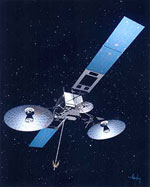Third Advanced Communications Satellite to Link US With Spac
by Goddard Space Flight Center
More articles in SatellitesNASA's latest Tracking and Data Relay Satellite, TDRS-J, will be able to transfer data at rates 5,000 times faster than the average 56K computer modem, and support Space Shuttle missions with high-resolution digital television. TDRS-J is scheduled to launch December xx aboard an Atlas IIA rocket from Cape Canaveral Air Force Station, Fla. at the beginning of a 40-minute launch window which opens at 10:xx p.m. EST.
TDRS-J is the third in a series of three advanced satellites that will provide researchers with unprecedented images from several NASA missions.
"This state-of-the-art communications system will support NASA's overall mission by helping us better understand and protect our home planet, explore the universe, search for life, and inspire the next generation of explorers," said Robert Jenkens Jr., TDRS Project Manager at NASA' Goddard Space Flight Center, Greenbelt, Md.
The enormous amount of scientific data, flowing through the TDRS fleet, benefits people everywhere. TDRS supports several NASA Earth and space science missions, such as the Hubble Space Telescope, which helps scientists explore the birth and death of stars, Landsat 7, which helps farmers and urban planners wisely use the Earth's valuable natural resources, and the Tropical Rainfall Measuring Mission, which provides scientists with accurate rainfall measurement maps. TDRS' advanced capabilities make all of this possible.
 The Tracking and Data Relay Satellite-J
The Tracking and Data Relay Satellite-J In addition to providing existing S-band Single Access and Ku-band Single Access capabilities, TDRS-J will provide users with the following new services:
Ka-band Single Access: This new higher-frequency service, which operates from 22.5 to 27.5 Gigahertz and increases data rate capabilities to 800 megabits per second, will provide communications with future missions requiring higher bandwidths such as multi-spectral instruments for Earth science applications. This frequency also is less susceptible to interference from our increasingly busy radio environment. Two 15-foot-diameter flexible graphite mesh antenna reflectors provide the accurate and steerable response for the Ka-band operating frequency. The reflectors, which remain folded during launch, 'spring back' to their original cupped circular shape once on orbit.
Multiple Access: The system is capable of receiving signals from five user spacecraft simultaneously at rates up to 3 megabits per second, while transmitting to a single user at up to 300 kilobits per second. Operates using a phased-array antenna in the 2.0 to 2.3 GHz range.
Transfer orbit operations, which are scheduled to occur during a two-week period following the launch, will boost the 7,042-pound (3,197-kilogram) spacecraft to a geosynchronous orbit 22,300 miles above the Earth's equator.
Fully deployed, the satellite will measure approximately 69 feet long (21 meters) by 4e feet (13 meters) wide. The satellite's silicon celled solar arrays will generate 2,300 watts of on-orbit power. A nickel-hydrogen battery aboard TDRS-J will supply power during solar eclipses.
The TDRS replenishment program cost approximately $800 million and includes the three satellites, associated expendable launch vehicles, upgrades to the White Sands Complex and NASA program costs.
Boeing Satellite Systems of El Segundo, Calif., designed, built and tested TDRS-H, I and J for NASA under a fixed-price contract.